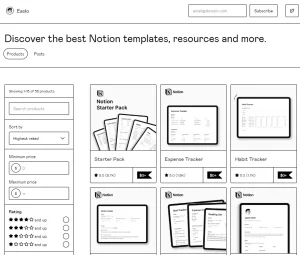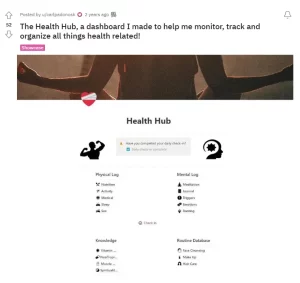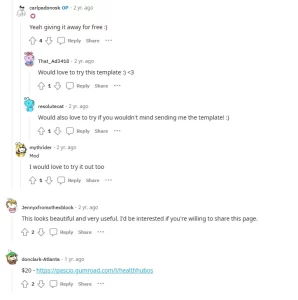This blog post is about one of the best money-making opportunities online today. It is a case study of digital creators- Easlo and another young entrepreneur, Pascio, who is killing it on Notion, Gumroad & X. You will learn their strategies and how to copy their success.
This is one of the most overlooked income streams online.
Yet some young creators with fewer social media followings and almost no skills are killing. While some have even turned it into a full-time job, others enjoy it as a side gig.
In this Blog Post, we break down the success story of Easlo, a 22-year-old Notion digital creator from Italy who has made over $20,000 per month in 2022 with average revenue per customer of around $30 by selling digital products.
This blog post will also give you an insight into the journey of Pascio, another young digital creator making over $1,00,000 a year on Notion, and provide a roadmap to copy their success.
Ready?
Let’s dive in.
The Biggest Challenge of Earning Online
What are the sources to make money, and from where?
There are so many options & platforms.
The strategies are on the internet but so dispersed that they leave you overwhelmed.
Or else, you need a course to understand the nuances involved- choosing a good and reasonably priced course is another fight.
Even if you manage to figure out the strategies, you still need to:
- create a website and
- collect payments
However, recently, there’s a more inclusive platform that does not require exceptional skills and has been quietly reshaping the creator economy.
You may have heard about it: Gumroad.
What’s unique about Gumroad?

The psychology of internet users on a given platform is distinct; if you understand it, you can make unfair amounts of money.
However, most people misuse the platform features and simply recycle content across platforms or promote their affiliate links.
Gumroad, however, thrives on its distinct psychology: promoting and benefiting from each other’s products.
Gumroad has redefined Affiliate Marketing. Unlike traditional platforms where affiliate marketing can be murky, Gumroad guarantees trust. You promote a product; you get paid in real time. No deceit, no waiting.
Think of Gumroad as your online store without the fuss of website management. It’s perfect for selling a variety of digital goods. But, like any store, you need to bring in customers.
Boosting Sales: The Power Duo of Gumroad and X (Twitter)

X or Twitter drives most Gumroad sales. They’re interconnected. Want to establish yourself on Gumroad? Start on Twitter.
A Simple Strategy for Twitter Sales:
- Use tools like Tweet Hunter to schedule content, growing your audience over time.
- Create Tweet Threads and conclude with a link to your Gumroad product.
So, it’s about sharing value and subtly leading your audience to your Product. It’s that straightforward.
Other social media apps or sites can push direct traffic, but Twitter is the easiest because Twitter users love to buy stuff from Gumroad- it’s built into user psychology.
What is Notion?

Notion is a powerful and versatile app that allows users to create, organize, and share their personal and professional projects. Notion has over 30M users and is growing every day. And the demand for Notion templates is ever-increasing.
Notion has gained popularity among students, entrepreneurs, freelancers, and creatives who use it to manage their workflows, goals, tasks, notes, and more.
But did you know that you can also make money with Notion and that too plenty?
Time to Steal the Legend(s)
Let’s explore how Easlo, a digital creator from Italy, made over $100,000 in one year by creating and selling Notion templates on Gumroad. Also, how Pascio, another young Entrepreneur, killed it using a similar strategy.
1. Easlo, The Notion Guy:
Who is Easlo?

Easlo is the online alias of Jason Ruiyi Chin, a 22-year-old digital creator who lives in Italy. He started using Notion in 2020 to organize his school notes and personal projects. He was fascinated by the app’s functionality and flexibility and began experimenting with different templates and layouts.
He decided to share his creations on Twitter, where he found a community of Notion enthusiasts who appreciated his work. He received positive feedback and requests for more templates, encouraging him to start selling them on Gumroad, a platform allowing creators to sell digital products.
What are Notion templates?

Notion templates are pre-made Notion pages that users can duplicate and customize for their own needs. They can range from simple checklists and calendars to complex dashboards and systems. Notion templates can help users save time and effort by providing ready-made solutions for everyday problems or goals.
Some examples of popular Notion templates are:
- Personal dashboard: A central hub that connects all your Notion pages and shows your daily agenda, tasks, goals, habits, etc.
- Project tracker: A system that helps you plan, manage, and track your projects from start to finish.
- Journal: A space to reflect on your thoughts, feelings, experiences, and learnings.
- Resume: A professional and elegant resume that showcases your skills, achievements, and personality.
- Portfolio: A showcase of your work, projects, or products demonstrating your value and expertise.
How did Easlo create and sell his Notion templates?
Easlo followed a 10-step, simple, but effective process to create and sell his Notion templates. Here are the steps he took:
1. He identified a problem or a need that he or his potential customers had.
For example, he wanted to create a personal dashboard to help him stay organized and productive.
2. He researched the best practices and solutions for that problem or need.
He looked at other Notion templates, blogs, videos, books, etc., to get inspiration and ideas.
3. He designed and built his own solution using Notion. He used his creativity and skills to create a unique and helpful template that solved the problem or met the need.
4. He tested and improved his template.
He used his template himself and asked for feedback from other Notion users. He made changes and enhancements based on the results.
5. He prepared his template for sale.
He cleaned up his template by removing any personal or irrelevant information. He added instructions and tips on how to use the template. He also created a catchy name and a logo for his template.
6. He created a sales page for his template on Gumroad.

He wrote a compelling description explaining his template’s benefits and features. He added screenshots and testimonials to showcase his template. He also set a fair price for his template based on its value.
7. He promoted his templates on Twitter.

He used Twitter (now X) as his primary platform to distribute his Notion Templates and resources. He posted regularly about his template using engaging content such as videos, images, polls, etc. He also interacted with other Notion users and influencers by commenting, liking, retweeting, etc.
Also, he knew that distributing free products was the initial step to building trust in the community. So, he leveraged X to distribute free Notion templates to the Notion Community from time to time.
8. He delivered his template to his customers via Gumroad.
He ensured his customers received their template as soon as they purchased it. He also provided support and updates to his customers via email or Twitter.
9. After Easlo gained traction, he began leveraging his email list.

Easlo got more followers on Twitter and began his newsletter and, later, his website.
The newsletter was a way to connect with his faithful fans who loved his products.
Easlo keeps giving his newsletter readers free Notion templates and tips to help them in their jobs and daily lives.
10. Easlo released bigger and better products.
Easlo then started to scale his collection by launching more comprehensive Notion dashboards and systems. This helped Easlo build a brand and made it easy for him to upsell his new products to previous customers.
How much did Easlo make with his Notion templates?

Easlo started selling his first paid Notion template in November 2020. Since then, he has created and sold over 20 different templates. Some of his most popular templates are:
- Study Quest: A gamified system that helps students study better by turning their tasks into quests.
- Resume Builder: A tool that helps users create stunning resumes in minutes.
- Dashboard Kit: A collection of 10 ready-made dashboards for different purposes such as productivity, finance, health, etc.
According to Gumroad’s public data Easlo made over $239,000 in 2021 by selling his Notion templates. He also made over $20,000 per month in 2022. His average revenue per customer was around $30.
What are the key takeaways from Easlo’s success story?
Easlo’s success story shows that it is possible to make a lot of money with Notion by creating and selling templates. Here are some of the key takeaways from his story:
- You don’t need to be an expert or have a large audience to start selling Notion templates.
Easlo started from scratch and learned by doing. He also grew his audience organically by providing value and engaging with his community.
- You need to create templates that solve real problems or meet real needs.
Easlo focused on creating templates that helped him or his customers achieve their goals or improve their lives. He also researched and tested his templates to ensure they were effective and useful.
- You need to market your templates well. Easlo used Gumroad as his platform to sell his templates.
He also used Twitter as his main channel to promote his templates. He created attractive and informative sales pages and posts that showcased his templates and convinced his customers to buy them.
Here’s another lesser-known Gumroad legend named Pascio, whom you can copy. He is unknown in most circles but is crushing it like Easlo.
2. Pascio, The Notion ambassador

Who is Pascio?
Pascal K, aka Pascio, is a cool guy. He is a Notion Ambassador, Consultant, and creator of more than 50+ free & premium Notion templates that have served 50,000+ people across the globe.
He is passionate about using no-code tools to solve problems for himself and others by ideating, building, launching and selling Notion templates.
He succeeded by following a process similar to Easlo.
- Pascio’s first Product:

He built his first Notion template some two years back, and it was a health-tracking system that helped him track his workouts, nutrition and self-development.
He ended up sharing this template on Reddit (r/Notion).
- Validating the Product

Everyone on Notion subreddit started asking for the template.

So, Pascio instantly recognized the demand for these templates, and he then decided to try and charge money for it.
- The Product launch
He put his template up for sale on Gumroad (for $15).
Next, he launched the template on Producthunt.
On the first day, Pascio made $100. The next day, $200.
After a week, he had made $500 out of thin air.
- Creating more products
Now, Pascio thought that if he could make $500 off one Product, how about multiple products?
So, he started building new products that solved problems for others.
Some of the templates that Pascio has created include:
1. Course Architect: A template designed to help creators build and launch their courses on Notion.
2. Email Architect: A template that allows users to create and send emails using Notion’s database and page properties.
3. 7 Free Templates Bundle: A bundle of 7 free templates for Notion designed to help anyone start building their own workspace.
4. Productivity Pack: A collection of 5 templates that help users organize their personal and professional lives, including a habit tracker, a goal planner, a project manager, a reading list, and a weekly planner.
5. Self-Improvement Pack: A set of 4 templates that help users track their personal growth and development, including a gratitude journal, a mood tracker, a self-care planner, and a vision board.
6. Ultimate ChatGPT Bundle: A bundle of 2500+ prompts, a Notion system, and a GPT-4 Mastery Course to help users master the art of conversational AI.
- Scaling with upsells and bundles
Pascio realized that the more products he had, the more upsells and bundles he could make.
If a customer came to spend $15, they usually left spending $60. This is because there were so many products to pick from.
Pascio crafted better offers, bundles and upsells for these customers.
Later, after six months, he made enough money to quit his 9-5 job. He then started building more advanced templates and raising the prices to reflect that.
Thus, his income kept on growing.
- Reaching the next level with email marketing
By this time, Pascio had already built an email list of 50K customers and had started sending emails to this list. He sent offers & discounts to the list, and it was like he could suddenly print money on demand.
Thus, finally, Pascio’s success formula boils down to the following:
- Find a Niche and create a product (here, Notion Template) that solves a genuine problem
- Validate the Product by sharing on social media like relevant subreddits or X
- Put the Product for sale on Gumroad
- Then, launch the Product on Producthunt
- Do upsells and bundles
- Simultaneously build your email list and leverage it to make more sales by sending offers and discounts
- Get paid on autopilot
How can you start making money with Notion?
If you are interested in following the footsteps of Easlo & Pascio and making money with Notion, here are some steps you can take:
1. Start using Notion yourself and explore its features and possibilities.
You can also check out other Notion templates, blogs, videos, subreddits, Facebook groups related to Notion, etc., to get inspiration and ideas.
Some popular Notion communities/groups are as follows:
Free Notion Templates|Facebook
No Cost Notion Templates & Tools
. Identify a problem or a need that you or your potential customers have.
Consider what kind of template would help you or them solve that problem or meet that need. Easlo’s #1 tip is to ask a community where your target customers hang out what problem drives them nuts.
3. Study the legends and design & build your own solution using Notion.
Go on YouTube and watch other creators build. People like Chris Notion and Tom Frank are very popular choices to get inspired for Notion skills. Here are some examples:
Then, use your creativity and skills to create a unique and helpful template that solves the problem or meets the need.
4. Test and improve your template.
Use your template yourself and ask for feedback from other Notion users. Make changes and enhancements based on the results.
5. Prepare your template for sale.
Clean up your template by removing any personal or irrelevant information. Add instructions and tips on how to use the template. Also, create a catchy name and a logo for your template.
6. Create a sales page for your template on Gumroad.
Write a compelling description that explains the benefits and features of your template. Add screenshots and testimonials to showcase your template. Also, set a fair price for your template based on the value it provides.
7. Promote your template on X or other social media platforms.
Post regularly about your template using engaging content such as videos, images, polls, etc. Also, interact with other Notion users and influencers by commenting, liking, retweeting, etc.
8. Deliver your template to your customers via Gumroad.
Ensure your customers receive their template as soon as they purchase it. Also, provide support and updates to your customers via email or Twitter.
Final Thought
Hope that this case study has inspired you to start your own Notion business or side hustle.
Notion is not only a great app for personal and professional use but also an excellent opportunity for making money online.
The combined forces of Notion, Gumroad and X are helping both the big-time and small-time creators.
Gumroad reinvented the affiliate marketing model and built it into its platform.
X is the ultimate tool to drive sales.
You can turn your passion and skills into profit by creating and selling Notion templates. Don’t sleep on this opportunity like most of the people.
Go make your first $1000 and change your life!

